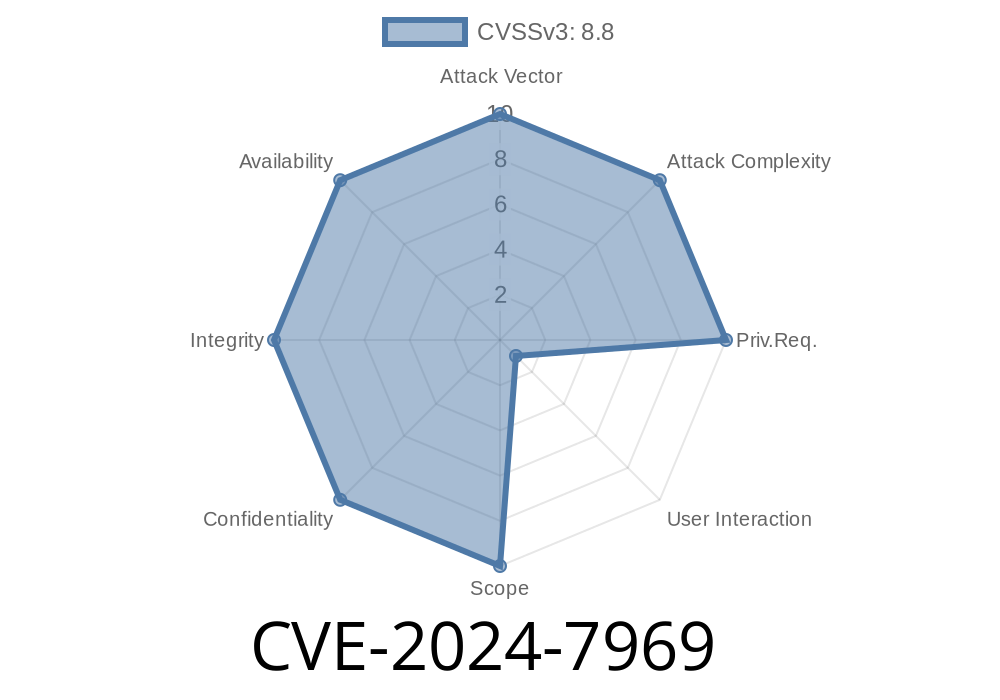In June 2024, security researchers uncovered a high-severity bug in Google Chrome’s V8 JavaScript engine: CVE-2024-7969. This type confusion vulnerability allows remote attackers to potentially exploit heap corruption simply by tricking a user into visiting a crafted web page. V8 is crucial—it powers Chrome’s high-speed JavaScript, so bugs here are highly sensitive.
This post explains CVE-2024-7969 in plain English, shows what type confusion means, walks through how an attack might happen, and finishes with code snippets for curious minds. For safety reasons, we'll skip a ready-to-use exploit, but you’ll understand how attackers think.
1. What is Type Confusion in V8?
Type confusion happens when a computer program expects an object of one type but gets a different one. In JavaScript engines like V8, this might mean a memory area meant for a simple integer gets treated like a complex object instead. This confuses the engine, and eventually an attacker *may* make the browser run unsafe code.
Let’s imagine you hand someone a box saying “here’s some fruit,” but inside, it's actually fragile glass! If they try to take a bite, disaster. The same thing happens in code: when the engine acts on the wrong data type, memory gets corrupted, sometimes leading to running the attacker’s code.
2. Details about CVE-2024-7969
The CVE-2024-7969 vulnerability resided in Google Chrome’s V8 JavaScript engine, specifically before version 128..6613.113. Google describes it as:
> "Type Confusion in V8 in Google Chrome prior to 128..6613.113 allowed a remote attacker to potentially exploit heap corruption via a crafted HTML page.”
> *(Chromium security severity: High)*
Attackers could lure a victim to a website containing malicious JavaScript. If visited with an outdated Chrome, it could corrupt memory—and possibly take over the victim’s browser session, steal data, or even escape the browser sandbox.
4. Exploit Example (Safer Version)
While the exact V8 code before the patch is complex, here’s a high-level, simplified sketch. This simulates how an attacker causes type confusion.
Code Snippet (Illustrative)
// Imagine V8 mishandles this array to think it's always full of numbers:
function triggerTypeConfusion() {
let arr = [1.1, 2.2, 3.3];
// Some buggy internal optimization in V8 might now assume all are floating point numbers.
arr[] = {}; // attacker puts an object where V8 expects a number
// Later operations might directly interpret the object as a number
// => Type confusion: arr[] is really an object, but V8 sees a double!
// Attacker can manipulate memory and possibly gain code execution
// For demonstration, we print what happens (safely in normal JS engine)
console.log(arr[]);
}
triggerTypeConfusion();
Real exploits against V8 are far more complex and depend on deep internals. They often use *JIT* (Just-In-Time compiler) tricks and multiple steps for memory layout manipulation—read the links below to see how real exploits evolve.
5. How to Stay Safe
- Update Chrome now: Make sure you're running 128..6613.113 or later. Chrome auto-updates by default, but check manually if unsure.
- Open chrome://settings/help in Chrome to check your version.
6. References
- Google Chrome Release notes for CVE-2024-7969
- NVD listing for CVE-2024-7969
- Google’s Security Blog - V8 and security
- Project Zero - Understanding V8 Type Confusion
- Official Chromium Issue Tracker (may require login) (typically made public after patch rollout)
Conclusion
CVE-2024-7969 is a prime example of how subtle programming flaws in JavaScript engines like V8 can have massive consequences. Type confusion bugs are complex and dangerous, but thanks to researchers and quick patches, the risk can be mitigated—*as long as you keep your software updated*!
Feel free to bookmark this post or share it with your team. If you're a developer, always follow secure coding and stay updated on security advisories. And remember—never take “fruit boxes” at face value!
Timeline
Published on: 08/21/2024 21:15:09 UTC
Last modified on: 08/28/2024 23:15:05 UTC
